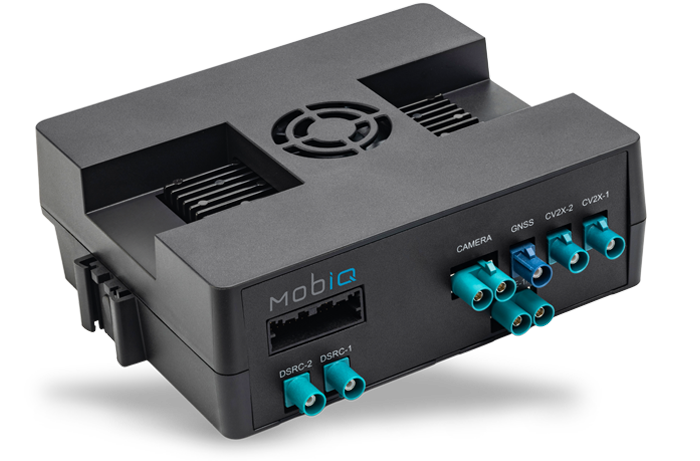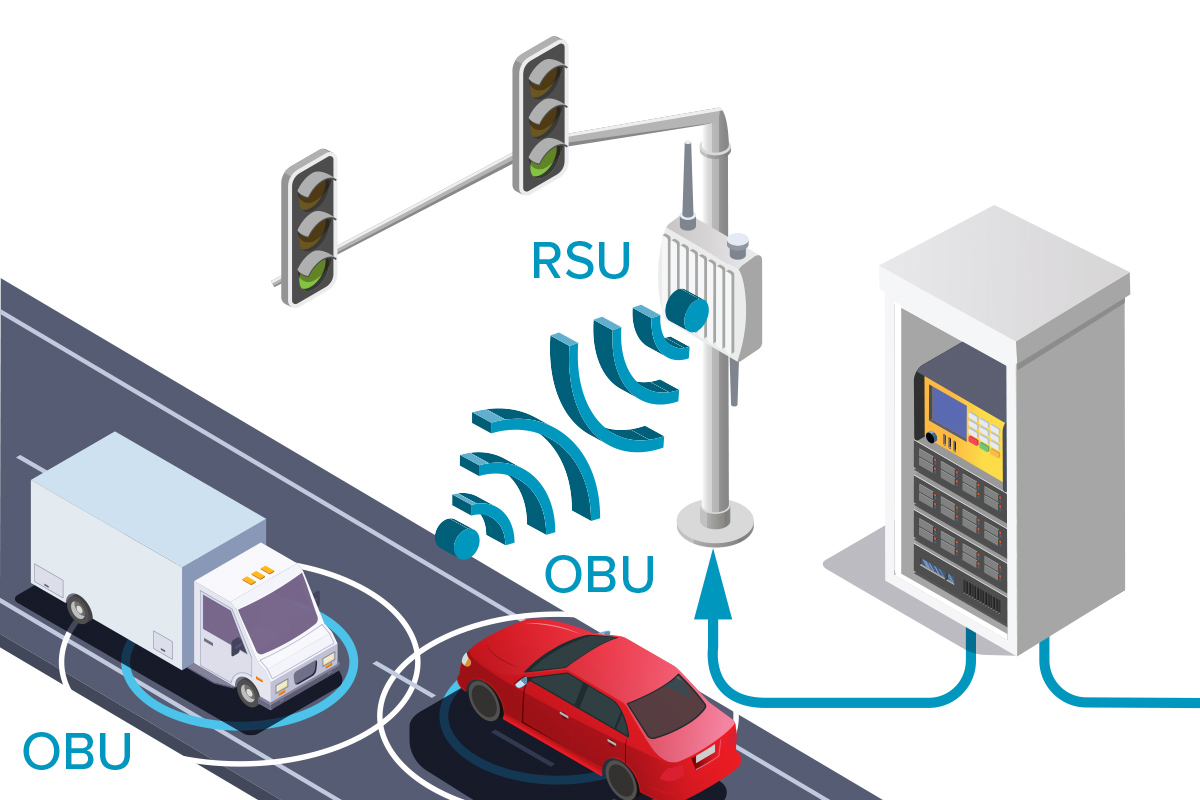Onboard Unit - OBU
Automotive Grade, Designed to Deliver Exceptional Performance
MobiQ’s OBU is a vehicle-installed hardware device that enables vehicles to communicate with one another and surrounding infrastructure to reduce accident risk and emissions, and improve traffic flow.
- C-V2X Operation
- Vehicle CAN Bus Connectivity
*Requires vehicle CAN information - Support for end customer specific software customization
- Standards: 3GPP R14/R15 (PC5 C-V2X), IEEE 1609, SAE J2735, SAE J2945/1, SAE J3161/1

V2I Applications
- Red Light Violation Warning (RLVW) — Uses MAP/SPAT Messages
- Transit Signal Priority (TSP) — Uses SRM/SSM Messages
- Emergency Vehicle Priority (EVP) — Uses SRM/SSM Messages
- Freight Signal Priority (FSP) — Uses SRM/SSM Messages
- Pedestrian Collision Warning (PCW) — Uses PSM Messages
- SPAT Signal Countdown — Uses MAP/SPAT Messages
- Curve Speed Warning (CSW) - Uses TIM Messages
- End of Ramp Deceleration Warning (ERDW) — Uses TIM Messages
- Wrong Way Entry (WWE) — Uses MAP/SPAT Messages (HV prevention) and TIM Messages (RV alerting)
- Configurable alerts based on TIM messages
V2V Applications
Uses BSM Messages
- Forward Collision Warning (FCW)
- Electronic Emergency Brake Light (EEBL)
- Intersection Movement Assist (IMA)
- Blind Spot/Lane Change Warning (BSW/LCW)
Server Connectivity
- OTA Software and/or Configuration Update
- Log Files Upload
- Security certificate top off
Roads and Drivers: Made Better by MobiQ’s OBU
The MobiQ Onboard Unit is designed to facilitate advanced vehicle safety and mobility features through Vehicle-2-Everything technology, the Roadside Unit (RSU), and other smart city technology. MobiQ has built on the success of the Wireless Safety Unit product line to create a highly capable development platform bringing together the latest short-range and wide-area automotive communication technologies. The OBU enables communication between other OBU-equipped vehicles, the Roadside Unit, and other infrastructure to send and receive information critical to the safe and efficient use of roadways.
Functions of the OBU

Information Broadcasting
The OBU relays information such as vehicle location, speed, and acceleration to infrastructure nodes and other vehicles, facilitating dynamic traffic management, congestion mitigation and reduced carbon emissions.

Information Listening
The OBU receives information such as data about vehicle position, speed, and acceleration, gleaned from GPS and onboard sensors. Information is also received from surrounding infrastructure, including traffic updates, road conditions, and weather forecasts, enabling drivers to make informed decisions about route planning and navigation. Additionally, the OBU can receive alerts and warnings about hazards, accidents, and road closures, facilitating proactive responses to ensure road safety.
Enhanced Awareness Means
Enhanced Safety and Mobility
MobiQ's OBU can be implemented to address many of the issues presented by road travel today. In logistics, OBUs facilitate fleet management by providing real-time data on vehicle location. They also play a crucial role in the development of smart cities by supporting traffic management systems to alleviate congestion and enhance urban mobility. In automotive safety, OBUs are integral in providing critical information to drivers, such as weather and road hazard warnings, and support features such as collision avoidance. When cities and drivers are more informed the experience of road travel evolves for the better.
V2X Application Suite
Transit Signal Priority (TSP)

Emergency Vehicle Preemption (EVP)

Freight Signal Priority (FSP)
Pedestrian Collision Warning (PCW)
Red Light Violation Warning (RLVW)
Intersection Movement Assist (IMA)
Speed Warnings

Construction
Information
Special Event
Information
Animal Crossing Alerts
Weather Condition
Alerts

Emergency Electronics Brake Light (EEBL)

Forward Collision Warning (FCW)

Wrong Way Driving

Blind Spot/Lane Change Warning (BSW/LCW)

Signal Countdown
Cutting-edge Technology
Engineered for the Long-haul
MobiQ has leveraged over a decade of research and development expertise working with relevant standards bodies, government research organizations, and OEMs to develop a platform capable of meeting anticipated minimum performance requirements and supporting initial V2X use cases for day 1 deployment and beyond.
Quality & Durability
Developed according to the stringent quality process DENSO has instituted for automotive parts, differentiating MobiQ’s RSU from competitors.
Interoperability
MobiQ’s OBU is compatible with a wide range of infrastructure devices from various manufacturers.
Vehicle Integration
The OBU can be integrated into any vehicle, from passenger cars to commercial trucks and beyond.
Designed for Road and Cyber Safety
Along with the increase of V2X technology, the potential for cyber attack is a rising concern for agencies and manufacturers. MobiQ's compliance with automotive software cybersecurity standards is paramount to ensure robust protection against cyber threats, as well as maintaining confidence in V2X technology. MobiQ products adhere to established cybersecurity standards, safeguarding against unauthorized access, data breaches, and manipulation of critical systems. By prioritizing compliance with these standards MobiQ mitigates the risk of cyber attacks, and contributes to the safety and reliability of connected automotive systems.
- Uses the latest generation V2X hardware security module for tamper resistant key storage
- V2X Hardware Security Module (HSM) (x2)
- 15-year key storage
- FIPS 140-2 Hardware Security Module

Technical Specifications
The MobiQ OBU is designed to support the development of advanced vehicle safety and mobility features. It is a vehicle-installed hardware device that enables vehicles to communicate with one another and surrounding infrastructure to reduce accident risk and emissions, and improve traffic flow.
- Includes C-V2X to enable V2X performance benchmarking and technology transition strategies, plus LTE & support for external Wi-Fi/Bluetooth module.
- Server Configurations - OTA software and configuration update, log file upload, and integration with the Security Credential Management System (SCMS)
Features
- Modular design with plug-in daughter cards
- Supports US (IEEE, SAE) V2X protocols
- V2X Facilities Software (SAE protocols)
- V2X Services API (CAN, GNSS, V2X Radio)
- Quad-core ARM Automotive System On-Chip
- LPDDR4 SDRAM / NOR Flash
- eMMC
- GNSS w/ multi-constellation support
- 4G LTE Modem
- 802.11ac Wi-Fi + Bluetooth 4.1 (Future capabilities)
- 2 Wire Ethernet / CANbus (x2)
- USB-C & USB Debug
- HDMI Output / Audio Output
V2X Standard Conformance
- IEEE 1609
- SAE J2735
- 3GPP R14 (PC5 C-V2X)
- SAE J2945/1
- SAE J3161/1
Frequency Band
- C-V2X: 5.9GHz ITS
- Support for external Wi-Fi/Bluetooth module: 2.4GHz/5GHz
- LTE: 2/4/5/7/12/13/17/29
- GNSS: L1 C/A, L1OF, B1, B1I, E1/BC
Bandwidth
- C-V2X (20 MHz)
Data Rate
- Support for external Wi-Fi/Bluetooth module: 300Mbps/24Mbps
- LTE: 600Mbps DL/50Mbps UL
Antenna Diversity
- C-V2X: RX-MRC
- Support for external Wi-Fi/Bluetooth module
- LTE: 2x2 MIMO
Max Transmit Power
- C-V2X: +23dBm
- LTE: +23dBm
Receiver Sensitivity (w/ diversity)
- C-V2X: -96.5 dBm
GNSS
- 2.0m CEP (10Hz)
Operating Temperature Range
- LTE: -30°C to +70°C
- All other systems: -30°C - 85°C
Dimensions
- 160mm x 138mm x 50mm (W x D x H)
Power Supply
- 12V (<22 Watts)
Vehicle Harness
- Vehicle wire harness
